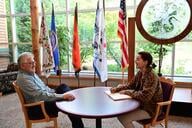You have /5 articles left.
Sign up for a free account or log in.
Australia’s controversial Western civilization courses are proving popular with students despite bitter opposition from many staff, data suggest.
 The extended majors in Western civilization at the University of Queensland (UQ) have some of the most demanding undergraduate entry scores in the country. Students require Australian Tertiary Admission Ranks (ATARs) of 95.85 or 98.5 (on a scale of 0 to 99.5), depending on whether the major forms part of an honors or double degree.
The extended majors in Western civilization at the University of Queensland (UQ) have some of the most demanding undergraduate entry scores in the country. Students require Australian Tertiary Admission Ranks (ATARs) of 95.85 or 98.5 (on a scale of 0 to 99.5), depending on whether the major forms part of an honors or double degree.
Such benchmarks exceed those imposed for the marquee courses typically targeted by top school students. UQ has published ATAR cutoff scores of 95 for medicine and 90 for law. Minimum entry scores for arts degrees at high-ranking Australian universities such as UQ, the University of Sydney and Monash University generally fall within the 70 to 80 range.
The University of Wollongong (UoW) said its bachelor of arts in Western civilization attracted average satisfaction ratings of 5.74, compared with 4.91 across the university as a whole, while almost 80 percent of the program’s students achieved final grades of distinction or better—results far exceeding the university average.
UoW and UQ were the first institutions to sign agreements with the Ramsay Centre for Western Civilization, which has pledged each university more than 50 million Australian dollars ($37 million) to bankroll the courses and associated scholarships over five years.
The programs commenced in 2020, taught in groups of about 10 per class—in stark contrast to many Australian undergraduate programs, where hundreds of students pack lecture halls—and with 30 students per intake attracting scholarships for up to five years.
Western civilization courses have encountered intense hostility at both institutions, along with the University of Sydney and the Australian National University, where negotiations with the Ramsay Centre collapsed. Staff said that the programs would undermine institutional autonomy and promote uncritically triumphalist perspectives of Western civilization to cadres of privileged white students—claims the universities deny.
“We work hard to ensure there is a diverse range of voices in the classroom,” said Alastair Blanchard, director of UQ’s Centre for Western Civilization. He said 20 percent of this year’s scholarship recipients claimed to have suffered “personal disadvantage,” such as financial hardship or personal trauma, during their schooling. At an institutional level, only about 10 percent of UQ students come from low socioeconomic backgrounds.
The Australian Catholic University, which introduced a B.A. in Western civilization in 2021, said its students included people of Chinese, Egyptian, Filipino and Indian heritage. About one-quarter came from outer suburban or regional areas and said that the scholarship was “making the difference,” according to program director Robert Carver. “[It] lifts a lot of the anxiety and makes it possible to come from a regional place to study in north Sydney.”
Another staff objection to the Ramsay Centre is that former conservative prime ministers John Howard and Tony Abbott sit on its board, with Howard as chair. While the board also includes former union leaders, critics say Howard and Abbott have had undue influence on the Ramsay curriculum.
“The people … who for 25 years were making humanities degrees more expensive and depriving us of funding have created this boutique program,” said Andrew Bonnell, UQ branch president of the National Tertiary Education Union. “If you do the dead Western people, you’re rewarded, and if you’re doing a more pluralist, academically oriented program, you’re getting punished.”
A Wollongong staff member, who asked not to be named, said it was no surprise that students were “having such a great time” in Ramsay courses. “They’re getting a kind of very spoiled private school experience in a sea of underfunded, strapped faculties.”
Ramsay Centre chief executive Simon Haines acknowledged that the program’s popularity owed much to the small-group format. “[It] means that teaching quality directly feeds into and is reflected in student engagement,” he said. “While we recognize that this model is hard to replicate at scale, given sector funding constraints, the student engagement metric … is the metric we are really interested in.”
Blanchard said that the courses appealed to students keen to engage with “big ideas” across a range of disciplines. “No other single major allows you to combine literature, political philosophy, art history, musicology, drama and jurisprudence in this way.” The works tackled in the courses were “not easy or superficial,” and students appreciated this.
Carver said his program aimed to look at Western civilization in its complexity, acknowledging its shortcomings. “To fix it or make it better, you have to understand it,” he said. “The students say, ‘My brain hurts—I’m having to challenge everything I believed up until now.’”




